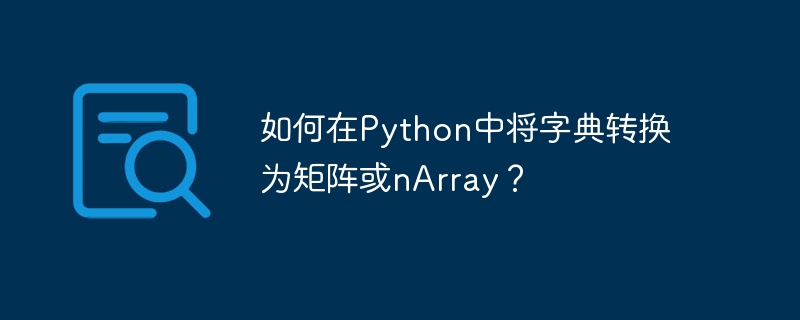如何在Python中将字典转换为矩阵或nArray?

在本文中,我们将向您展示如何使用Python的NumPy库中的array()函数将字典转换为矩阵或NumPy数组。
有时候需要将Python中的字典转换为NumPy数组,Python提供了一种高效的方法来实现这一点。将字典转换为NumPy数组会得到一个包含字典中键值对的数组。
在这个部分,我们将看一些在Python中将各种类型的字典转换为NumPy数组的示例
- 将字典转换为Numpy数组
- 将嵌套字典转换为Numpy数组
- 将具有混合键的字典转换为Numpy数组
numpy.array() 函数
它返回一个 ndarray。ndarray 是一个满足给定要求的数组对象。
要将字典转换为NumPy数组,Python提供了numpy.array()方法,但我们必须先进行一些准备工作。按照以下三个基本步骤作为前期任务。
- 首先,使用dict.items()来获取字典中的一组键值对。
- 然后,将这个组作为一个对象,使用 list(obj) 将其转换为一个列表。
- 最后,使用这个列表作为数据,调用 numpy.array(data) 将其转换为数组。
语法
numpy.array(object, dtype = None, *, copy = True, order = ‘K’, subok = False, ndmin = 0)
参数
object − 这是一个数组或任何暴露数组接口的对象。
dtype − 数组的首选数据类型。
copy − 如果为true(默认值),则复制该项。否则,只有当__array__返回一个副本时才会产生副本
order − 它表示数组的内存布局
subok − 如果为true,则子类会被传递;否则,返回的数组会被强制转换为基类数组(默认)
ndmin − 指示结果数组的最小维数。
Return Value − 返回一个ndarray(它是一个满足指定要求的数组对象)
将字典转换为Numpy数组
算法(步骤)
以下是执行所需任务的算法/步骤:
使用import关键字,导入具有别名(np)的numpy模块。
创建一个变量来存储输入的字典。
将 items() 函数(返回字典中的键值对组)应用于输入的字典,以获取字典中的所有键值对,并创建一个变量来存储它。
使用list()函数(返回一个可迭代对象的列表),将字典的所有键值对转换为列表数据类型。
使用NumPy模块的array()函数(返回一个ndarray。ndarray是一个满足给定要求的数组对象),将上述数据列表转换为NumPy数组。
将输入字典转换后的NumPy数组打印出来。
Example
以下程序使用array()函数将输入的字典转换为NumPy数组,并返回它 -
# importing numpy module with an alias name
import numpy as np
# creating a dictionary
inputDict = {1: 'Hello',
2: 'Tutorialspoint',
3: 'python'}
# getting all the key-value pairs in the dictionary
result_keyvalpairs = inputDict.items()
# converting an object to a list
list_data = list(result_keyvalpairs)
# converting list to an numpy array using numpy array() function
numpy_array = np.array(list_data)
print("Input Dictionary =",inputDict)
# printing the resultant numpy array
print("The resultant numpy array:\n", numpy_array)
输出
在执行时,上述程序将生成以下输出
Input Dictionary = {1: 'Hello', 2: 'Tutorialspoint', 3: 'python'}
The resultant numpy array:
[['1' 'Hello']
['2' 'Tutorialspoint']
['3' 'python']]
将嵌套字典转换为Numpy数组
算法(步骤)
以下是执行所需任务的算法/步骤:
创建一个变量来存储一个输入的嵌套字典(一个字典中包含另一个字典)。
使用 list() 函数(返回可迭代对象的列表)将字典的所有嵌套键值对转换为列表数据类型。
使用NumPy模块的array()函数将上述数据列表转换为NumPy数组。
将输入字典转换后的NumPy数组打印出来。
Example
以下程序使用array()函数将嵌套输入字典转换为NumPy数组,并返回它
# importing NumPy module with an alias name
import numpy as np
# creating a nested dictionary
nestedDictionary = {1: 'Hello',
2: 'Tutorialspoint',
3: {'X': 'This is',
'Y': 'python',
'Z': 'code'}}
# getting all the key-value pairs in the dictionary
result_keyvalpairs = nestedDictionary.items()
# converting an object to a list
list_data = list(result_keyvalpairs)
# converting list to an array using numpy array() function
numpy_array = np.array(list_data)
print("Input nested Dictionary = ",nestedDictionary)
# printing the resultant numpy array
print("\nThe resultant numpy array:\n", numpy_array)
输出
在执行时,上述程序将生成以下输出
Input nested Dictionary = {1: 'Hello', 2: 'Tutorialspoint', 3: {'X': 'This is', 'Y': 'python', 'Z': 'code'}}
The resultant numpy array:
[[1 'Hello']
[2 'Tutorialspoint']
[3 {'X': 'This is', 'Y': 'python', 'Z': 'code'}]]
将具有混合键的字典转换为Numpy数组
创建一个输入字典,其中包含字符串、整数、浮点数、列表等混合键,并用随机值填充它。
Example
以下程序使用array()函数将具有混合键的字典转换为NumPy数组,并返回它−
# importing numpy module with an alias name
import numpy as np
# creating a dictionary with mixed keys(like string and numbers as keys)
nestedDictionary = {'website': 'Tutorialspoint', 10: [2, 5, 8]}
# getting all the key-value pairs in the dictionary
result_keyvalpairs = nestedDictionary.items()
# converting an object to a list
list_data = list(result_keyvalpairs)
# converting list to an array using numpy array() function
numpy_array = np.array(list_data, dtype=object)
# printing the resultant numpy array
print("The resultant numpy array:\n", numpy_array)
输出
在执行时,上述程序将生成以下输出
The resultant numpy array: [['website' 'Tutorialspoint'] [10 list([2, 5, 8])]]
结论
在本文中,我们学习了字典中各种类型的键值对以及如何将它们转换为矩阵或Numpy数组。
以上是如何在Python中将字典转换为矩阵或nArray?的详细内容。更多信息请关注PHP中文网其他相关文章!

热AI工具

Undresser.AI Undress
人工智能驱动的应用程序,用于创建逼真的裸体照片

AI Clothes Remover
用于从照片中去除衣服的在线人工智能工具。

Undress AI Tool
免费脱衣服图片

Clothoff.io
AI脱衣机

AI Hentai Generator
免费生成ai无尽的。

热门文章

热工具

记事本++7.3.1
好用且免费的代码编辑器

SublimeText3汉化版
中文版,非常好用

禅工作室 13.0.1
功能强大的PHP集成开发环境

Dreamweaver CS6
视觉化网页开发工具

SublimeText3 Mac版
神级代码编辑软件(SublimeText3)

热门话题
 如何解决Linux终端中查看Python版本时遇到的权限问题?
Apr 01, 2025 pm 05:09 PM
如何解决Linux终端中查看Python版本时遇到的权限问题?
Apr 01, 2025 pm 05:09 PM
Linux终端中查看Python版本时遇到权限问题的解决方法当你在Linux终端中尝试查看Python的版本时,输入python...
 在Python中如何高效地将一个DataFrame的整列复制到另一个结构不同的DataFrame中?
Apr 01, 2025 pm 11:15 PM
在Python中如何高效地将一个DataFrame的整列复制到另一个结构不同的DataFrame中?
Apr 01, 2025 pm 11:15 PM
在使用Python的pandas库时,如何在两个结构不同的DataFrame之间进行整列复制是一个常见的问题。假设我们有两个Dat...
 如何在10小时内通过项目和问题驱动的方式教计算机小白编程基础?
Apr 02, 2025 am 07:18 AM
如何在10小时内通过项目和问题驱动的方式教计算机小白编程基础?
Apr 02, 2025 am 07:18 AM
如何在10小时内教计算机小白编程基础?如果你只有10个小时来教计算机小白一些编程知识,你会选择教些什么�...
 如何在使用 Fiddler Everywhere 进行中间人读取时避免被浏览器检测到?
Apr 02, 2025 am 07:15 AM
如何在使用 Fiddler Everywhere 进行中间人读取时避免被浏览器检测到?
Apr 02, 2025 am 07:15 AM
使用FiddlerEverywhere进行中间人读取时如何避免被检测到当你使用FiddlerEverywhere...
 Uvicorn是如何在没有serve_forever()的情况下持续监听HTTP请求的?
Apr 01, 2025 pm 10:51 PM
Uvicorn是如何在没有serve_forever()的情况下持续监听HTTP请求的?
Apr 01, 2025 pm 10:51 PM
Uvicorn是如何持续监听HTTP请求的?Uvicorn是一个基于ASGI的轻量级Web服务器,其核心功能之一便是监听HTTP请求并进�...
 Python中如何通过字符串动态创建对象并调用其方法?
Apr 01, 2025 pm 11:18 PM
Python中如何通过字符串动态创建对象并调用其方法?
Apr 01, 2025 pm 11:18 PM
在Python中,如何通过字符串动态创建对象并调用其方法?这是一个常见的编程需求,尤其在需要根据配置或运行...
 哪些流行的Python库及其用途?
Mar 21, 2025 pm 06:46 PM
哪些流行的Python库及其用途?
Mar 21, 2025 pm 06:46 PM
本文讨论了诸如Numpy,Pandas,Matplotlib,Scikit-Learn,Tensorflow,Tensorflow,Django,Blask和请求等流行的Python库,并详细介绍了它们在科学计算,数据分析,可视化,机器学习,网络开发和H中的用途







